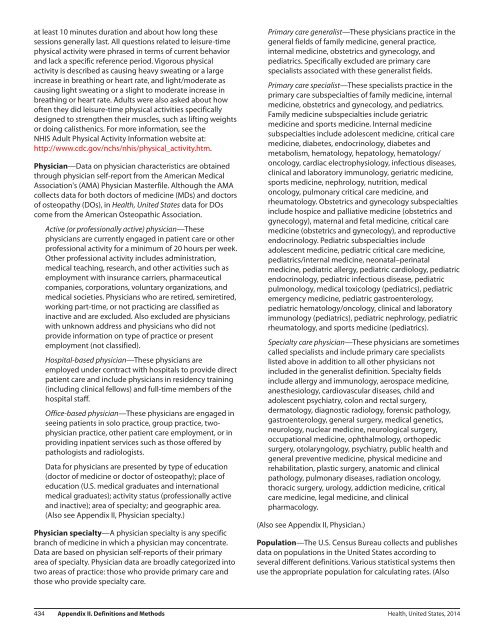hus14
hus14
hus14
Create successful ePaper yourself
Turn your PDF publications into a flip-book with our unique Google optimized e-Paper software.
at least 10 minutes duration and about how long these<br />
sessions generally last. All questions related to leisure-time<br />
physical activity were phrased in terms of current behavior<br />
and lack a specific reference period. Vigorous physical<br />
activity is described as causing heavy sweating or a large<br />
increase in breathing or heart rate, and light/moderate as<br />
causing light sweating or a slight to moderate increase in<br />
breathing or heart rate. Adults were also asked about how<br />
often they did leisure-time physical activities specifically<br />
designed to strengthen their muscles, such as lifting weights<br />
or doing calisthenics. For more information, see the<br />
NHIS Adult Physical Activity Information website at:<br />
http://www.cdc.gov/nchs/nhis/physical_activity.htm.<br />
Physician—Data on physician characteristics are obtained<br />
through physician self-report from the American Medical<br />
Association's (AMA) Physician Masterfile. Although the AMA<br />
collects data for both doctors of medicine (MDs) and doctors<br />
of osteopathy (DOs), in Health, United States data for DOs<br />
come from the American Osteopathic Association.<br />
Active (or professionally active) physician—These<br />
physicians are currently engaged in patient care or other<br />
professional activity for a minimum of 20 hours per week.<br />
Other professional activity includes administration,<br />
medical teaching, research, and other activities such as<br />
employment with insurance carriers, pharmaceutical<br />
companies, corporations, voluntary organizations, and<br />
medical societies. Physicians who are retired, semiretired,<br />
working part-time, or not practicing are classified as<br />
inactive and are excluded. Also excluded are physicians<br />
with unknown address and physicians who did not<br />
provide information on type of practice or present<br />
employment (not classified).<br />
Hospital-based physician—These physicians are<br />
employed under contract with hospitals to provide direct<br />
patient care and include physicians in residency training<br />
(including clinical fellows) and full-time members of the<br />
hospital staff.<br />
Office-based physician—These physicians are engaged in<br />
seeing patients in solo practice, group practice, twophysician<br />
practice, other patient care employment, or in<br />
providing inpatient services such as those offered by<br />
pathologists and radiologists.<br />
Data for physicians are presented by type of education<br />
(doctor of medicine or doctor of osteopathy); place of<br />
education (U.S. medical graduates and international<br />
medical graduates); activity status (professionally active<br />
and inactive); area of specialty; and geographic area.<br />
(Also see Appendix II, Physician specialty.)<br />
Physician specialty—A physician specialty is any specific<br />
branch of medicine in which a physician may concentrate.<br />
Data are based on physician self-reports of their primary<br />
area of specialty. Physician data are broadly categorized into<br />
two areas of practice: those who provide primary care and<br />
those who provide specialty care.<br />
Primary care generalist—These physicians practice in the<br />
general fields of family medicine, general practice,<br />
internal medicine, obstetrics and gynecology, and<br />
pediatrics. Specifically excluded are primary care<br />
specialists associated with these generalist fields.<br />
Primary care specialist—These specialists practice in the<br />
primary care subspecialties of family medicine, internal<br />
medicine, obstetrics and gynecology, and pediatrics.<br />
Family medicine subspecialties include geriatric<br />
medicine and sports medicine. Internal medicine<br />
subspecialties include adolescent medicine, critical care<br />
medicine, diabetes, endocrinology, diabetes and<br />
metabolism, hematology, hepatology, hematology/<br />
oncology, cardiac electrophysiology, infectious diseases,<br />
clinical and laboratory immunology, geriatric medicine,<br />
sports medicine, nephrology, nutrition, medical<br />
oncology, pulmonary critical care medicine, and<br />
rheumatology. Obstetrics and gynecology subspecialties<br />
include hospice and palliative medicine (obstetrics and<br />
gynecology), maternal and fetal medicine, critical care<br />
medicine (obstetrics and gynecology), and reproductive<br />
endocrinology. Pediatric subspecialties include<br />
adolescent medicine, pediatric critical care medicine,<br />
pediatrics/internal medicine, neonatal–perinatal<br />
medicine, pediatric allergy, pediatric cardiology, pediatric<br />
endocrinology, pediatric infectious disease, pediatric<br />
pulmonology, medical toxicology (pediatrics), pediatric<br />
emergency medicine, pediatric gastroenterology,<br />
pediatric hematology/oncology, clinical and laboratory<br />
immunology (pediatrics), pediatric nephrology, pediatric<br />
rheumatology, and sports medicine (pediatrics).<br />
Specialty care physician—These physicians are sometimes<br />
called specialists and include primary care specialists<br />
listed above in addition to all other physicians not<br />
included in the generalist definition. Specialty fields<br />
include allergy and immunology, aerospace medicine,<br />
anesthesiology, cardiovascular diseases, child and<br />
adolescent psychiatry, colon and rectal surgery,<br />
dermatology, diagnostic radiology, forensic pathology,<br />
gastroenterology, general surgery, medical genetics,<br />
neurology, nuclear medicine, neurological surgery,<br />
occupational medicine, ophthalmology, orthopedic<br />
surgery, otolaryngology, psychiatry, public health and<br />
general preventive medicine, physical medicine and<br />
rehabilitation, plastic surgery, anatomic and clinical<br />
pathology, pulmonary diseases, radiation oncology,<br />
thoracic surgery, urology, addiction medicine, critical<br />
care medicine, legal medicine, and clinical<br />
pharmacology.<br />
(Also see Appendix II, Physician.)<br />
Population—The U.S. Census Bureau collects and publishes<br />
data on populations in the United States according to<br />
several different definitions. Various statistical systems then<br />
use the appropriate population for calculating rates. (Also<br />
434 Appendix II. Definitions and Methods Health, United States, 2014


